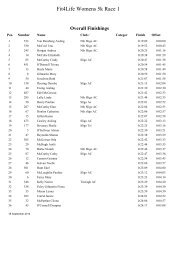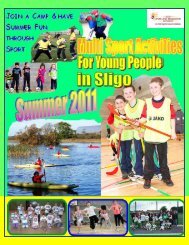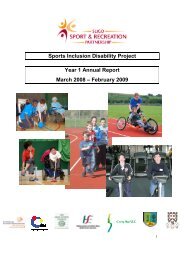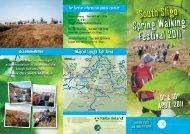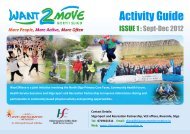Girls Active Programme - Sligo Sport and Recreation Partnership
Girls Active Programme - Sligo Sport and Recreation Partnership
Girls Active Programme - Sligo Sport and Recreation Partnership
You also want an ePaper? Increase the reach of your titles
YUMPU automatically turns print PDFs into web optimized ePapers that Google loves.
Findings<br />
“Health does come into the SPHE programme so it<br />
would support <strong>Girls</strong> <strong>Active</strong>. But there is a need to<br />
highlight it [<strong>Girls</strong> <strong>Active</strong>] more among staff, <strong>and</strong> to<br />
[link] <strong>Girls</strong> <strong>Active</strong> with Biology, Home Economics, <strong>and</strong><br />
so on ... <strong>Girls</strong> <strong>Active</strong> would have to be integrated as<br />
part of the PE programme eventually to make it part<br />
of the school programme. Then <strong>Girls</strong> <strong>Active</strong> would<br />
become a ‘whole school’ project’” (Principal)<br />
“The whole area of women in sport needs to be<br />
developed. It’s a very male-dominated sector. The<br />
image of the perfect woman out there is not a woman<br />
who plays sport, it’s a woman who is ‘beautiful’. Until<br />
that’s addressed ... English <strong>and</strong> Media Studies need<br />
to be integrated [into <strong>Girls</strong> <strong>Active</strong>]” (Co-ordinator)<br />
The principal commented that <strong>Girls</strong> <strong>Active</strong> has<br />
raised awareness in her school, <strong>and</strong> her expectation<br />
was that something like <strong>Girls</strong> <strong>Active</strong> would be<br />
included in planning for the extra-curricular <strong>and</strong><br />
Healthy Schools <strong>Programme</strong> in the school, but was<br />
accompanied by the concern that “... schools can<br />
only do so much”. She intends that the school will<br />
take on <strong>and</strong> continue with a similar programme to<br />
<strong>Girls</strong> <strong>Active</strong> when the current scheme ends. The<br />
co-ordinator took up the theme of the continuation<br />
of the programme with a reference to the voluntary<br />
contribution of teachers:<br />
“I could see it [<strong>Girls</strong> <strong>Active</strong> ] being maintained [in<br />
the school], but it depends on me or other teachers<br />
[being] volunteers <strong>and</strong> not getting paid”<br />
4.2.3 School C<br />
Background. School C took part in the first phase<br />
of <strong>Girls</strong> <strong>Active</strong> in 2003/4 <strong>and</strong> also participated<br />
in Phases Two <strong>and</strong> Three (2004/5 <strong>and</strong> 2005/6).<br />
The PE teacher was interested in the programme<br />
as she had noticed that “fewer girls were getting<br />
involved in sport <strong>and</strong> PE” 22 . Prior to <strong>Girls</strong> <strong>Active</strong>,<br />
she had organised ‘girls only’ days in the gym to<br />
encourage girls to participate in physical activities.<br />
The principal also observed that senior girls in<br />
particular were “opting out” <strong>and</strong> might respond<br />
better to girl-only activities.<br />
“The aim was to get girls involved in physical activity,<br />
<strong>and</strong> to enjoy it”<br />
The PE teacher subsequently became the coordinator<br />
of the programme in the school.<br />
In the first year of <strong>Girls</strong> <strong>Active</strong> at the school 2nd years<br />
were recruited onto the programme as “they were<br />
poor in PE” (co-ordinator). In subsequent years the<br />
same class year has participated but senior girls<br />
were also permitted to join in. Since numbers were<br />
relatively low, any girl from these years who wished<br />
to do so was allowed to participate so the activities<br />
in this instance were not confined to ‘non-sporty’<br />
girls.<br />
In 2004/5 eighteen 15-17yr old girls took part in<br />
the programme <strong>and</strong> the activities undertaken were<br />
dance, yoga <strong>and</strong> aerobics. All sessions took place<br />
on the premises in the evenings after school.<br />
Attitudes to physical activity. The girls expressed<br />
some dissatisfaction with arrangements for sports<br />
in the school where boys’ choices have tended to<br />
predominate (there are twice as many boys as girls<br />
attending the school).<br />
“<strong>Sport</strong>s in school are competitive sports like football.<br />
<strong>Girls</strong> <strong>Active</strong> is non-competitive - for the girls”.<br />
Timing of activities. <strong>Girls</strong> <strong>Active</strong> activities were<br />
transferred from lunchtime to after-school hours<br />
in 2004/5 due to a contraction in the length of<br />
lunchtime that made it no longer feasible to run<br />
<strong>Girls</strong> <strong>Active</strong> activities during that period. The girls<br />
said that lunch hour was rushed but that difficulties<br />
in arranging lifts home in the evening prevented<br />
them from attending <strong>Girls</strong> <strong>Active</strong> on occasions. The<br />
co-ordinating teacher elaborated on the problems<br />
of running activities after school time:<br />
“Last week one girl’s parent couldn’t come <strong>and</strong> that<br />
meant that three other girls who were travelling with<br />
her couldn’t come either”<br />
She also mentioned that some of the girls had to be<br />
elsewhere in the evenings, e.g. babysitting younger<br />
Evaluation of the <strong>Girls</strong> <strong>Active</strong> <strong>Programme</strong> - 2003 – 2005 Report 21



